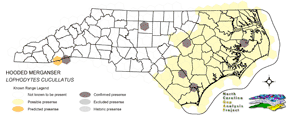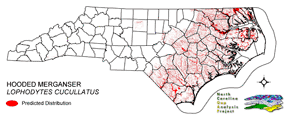
| Taxa: |
| Order: |
| Family: |
| Aves |
| Anseriformes |
| Anatidae |
| NatureServe Global Rank: |
| NatureServe State (NC) Rank: |
| G5 |
| S1B,S4N |
| Federal Status: |
| NC State Status: |
| --- |
| --- |


| Land Unit |
| US Fish & Wildlife Service |
| US Forest Service |
| US National Park Service |
| US Department of Defense |
| NC State Parks |
| NC University System |
| NC Wildlife Res. Com. |
| NC Forest Service |
| NC Div. of Coastal Mgmt. |
| Local Governments |
| Non-Governmental Org. |
| Other Public Lands |
| Private Lands |
| GAP Status 1-2 |
| All Protected Lands |
| Statewide |
| Hectares |
| 54,560.70 |
| 7,832.70 |
| 19,813.05 |
| 341.64 |
| 12,872.79 |
| 5,946.21 |
| 24,320.52 |
| 2,658.45 |
| 5,214.06 |
| 501.30 |
| 13,989.96 |
| 395.10 |
| 934,924.41 |
| 103,818.99 |
| 148,213.83 |
| 1,083,370.89 |
| Acres |
| 134,822.40 |
| 19,355.02 |
| 48,959.10 |
| 844.21 |
| 31,809.35 |
| 14,693.40 |
| 60,097.30 |
| 6,632.92 |
| 12,884.22 |
| 1,238.74 |
| 34,569.94 |
| 976.31 |
| 2,310,248.08 |
| 256,606.01 |
| 366,308.03 |
| 2,677,131.00 |
| % of Dist. on |
| Prot. Lands |
| 36.8 % |
| 5.3 % |
| 13.3 % |
| 0.2 % |
| 8.7 % |
| 4.0 % |
| 16.3 % |
| 1.8 % |
| 3.5 % |
| 9.4 % |
| 9.4 % |
| < 0.1 % |
| 0.2 % |
| 70.0 % |
| ----- |
| ----- |
| % of Dist. on |
| All Lands |
| 5.0 % |
| 0.7 % |
| 1.8 % |
| < 0.1 % |
| 1.2 % |
| 0.5 % |
| 2.2 % |
| 0.2 % |
| 0.5 % |
| < 0.1 % |
| 1.3 % |
| < 0.1 % |
| 86.3 % |
| 9.6 % |
| ----- |
| ----- |
|
Might be a rare breeder from the coast west to Wake County and Wilkesboro (Potter et al. 1980) Inhabits wooded areas with ponds, lakes, narrow rivers, creeks (Kaufman 1996), swamps, and beaver ponds (Bellrose 1976). Sometimes more open marshy areas if nesting cavities are present (Kaufman 1996). Lives in a similar habitat as that of the Wood Duck, but requires slower-moving water and less human activity (Bellrose 1976). Nests in a cavity such as a Pileated Woodpecker hole or nest box (Potter et al. 1980) from 10 to 80 feet above the ground in a tree near water (Kaufman 1996). Type of tree and height of cavity may be unimportant. Will also nest in a hollow stump or fallen hollow log (Harrison 1975). May share incubation with female Wood Ducks (Ehrlich et al. 1988). NATURE SERVE GLOBAL HABITAT COMMENTS: Streams, lakes, swamps, marshes, and estuaries; winters mostly in freshwater but also regularly in estuaries and sheltered bays (AOU 1983). Nests usually in tree cavities in forested regions near water, often near fast- flowing streams (AOU 1983), also forest ponds and lakes, flooded forest, riverside swamps. See Zicus (1990) for information on successful use of nest boxes in Minnesota. |
| Code | Name | Description | NC Natural Heritage Program Equivalent |
| 75 | Tidal Swamp Forest | Swamp tupelo dominated forest with or without black tupelo and/or cypress trees. Restricted to the tidal zones in the coastal plain. May have inclusions of coastal red cedar woodlands. | Tidal cypress - gum swamp |
| 380 | Coastal Plain Fresh Water Emergent | Emergent vegetation in fresh water seepage bogs, ponds and riverbeds of the coastal plain. Includes alliances dominated by sedges, eelgrass, as well as cane found in unforested cane-brakes. | Small Depression Pond, Sandhill Seep, Floodplain Pool, Unforested Floodplain Canebrake, Riverscour Prairies, Vernal Pools |
| 173 | Coastal Plain Riverbank Shrubs | Shrub dominated riverbanks, commonly dominated by willows and/or alders. | Sand and Mud Bar |
| 50 | Coastal Plain Mixed Bottomland Forests | Includes forests dominated by a variety of hardwood species, including sweetgum, cottonwood, red maple. | Coastal Plain Bottomland Hardwood (in part), Coastal Plain Levee Forest |
| 49 | Coastal Plain Oak Bottomland Forest | Bottomland forests dominated by deciduous oak alliances. Oaks represented can include swamp chestnut, cherrybark, willow, and/or overcup oak. Inclusions of loblolly pine temporarily flooded forests occur in patches. Hydrology is temporarily to seasonally flooded. | Coastal Plain Bottomland Hardwoods (in part) blackwater subtype, brownwater subtype |
| 158 | Coastal Plain Nonriverine Wet Flat Forests | Loblolly pine - Atlantic white-cedar - red maple - swamp tupelo saturated forests as well as forests dominated by loblolly, sweetgum, and red maple in non-riverine flats. | Non-riverine Wet Hardwood Forest |
| 15 | Seepage and Streamhead Swamps | Includes extensive peat flats in the coastal plain, dominated by swamp tupelo, maples, and Atlantic white cedar alliances. In the sandhills includes streamhead pond pine and bay forests alliances. Saturated hydrology. | Bay Forest, Small Depression Pocosin, Streamhead Atlantic White Cedar Forest, Streamhead Pocosins |
| 30 | Cypress-Gum Floodplain Forests | Swamps dominated by black or swamp tupelo with or without Taxodium. Seasonally to semi-permanently flooded hydrology. | Cypress-Gum Swamps |
| 78 | Pond-Cypress - Gum Swamps, Savannas and Lakeshores | Cypress dominated swamps and lakeshores. Can include bays dominated by pond cypress or shorelines of coastal plain lakes with a narrow band of cypress. | Non-riverine Swamp Forest, Natural Lakeshores (in part) |
| 385 | Oak Bottomland Forest and Swamp Forest | The swamp chestnut oak, cherrybark oak, shumard oak and sweetgum alliance is one representative. Other alliances are dominated by water, willow, and overcup oaks. Swamp forests can be dominated by sweetgum, red maple, and black gum being dominant. Loblolly can occur in combination with sweetgum and red maple, or with tulip poplar. Includes saturated and semi- to permanently flooded forests in the mountains. | Piedmont/Mountain Bottomland Forest, Piedmont/Mountain Swamp Forest |
| 63 | Coastal Plain Mesic Hardwood Forests | Beech dominated forests with white oak and northern red oak as possible co-dominants. Dry-mesic to mesic forests on slopes and small stream bottoms in the coastal plain. | Mesic Mixed Hardwood Forest, Basic Mesic Forests |
| 138 | Coastal Plain Dry to Dry-Mesic Oak Forests | Oak dominated forests of the coastal plain. Includes white oak forests with water oak or northern red oak and hickories as co-dominants. | Dry Mesic Oak Hickory Forest, Basic Oak Hickory Forest, Dry Oak Hickory Forest |
| 238 | Piedmont/Mountain Submerged Aquatic Vegetation | Seasonally to permanently flooded areas with aquatic vegetation. Waterlily, pondweed, hydrilla smartweed are a few of the species that can occur. | Piedmont/Mountain Semipermanent Impoundment (in part) |
| 239 | Piedmont/Mountain Emergent Vegetation | Emergent vegetation of all wetland hydrologies. Sites would commonly support species such as tussock sedge, rushs, and cattail alliances. | Rocky Bar and Shore (in part) |
| 267 | Riverbank Shrublands | Riverside shrubs with temporarily flooded hydrologies. Found in the both the Mountains and Piedmont. Containing dominants such as smooth alder and a Carolina or black willows. | Sand and Mud Bar |
| 269 | Floodplain Wet Shrublands | Saturated shrublands of the Piedmont, includes buttonbush, swamp-loosestrife, decodon and alders. | Piedmont/mountain Semipermanent Impoundment |
| 384 | Piedmont/Mountain Mixed Bottomland Hardwood Forests | Includes temporarily to seasonally forests dominated by hardwood species. Hardwoods include sweetgum, red maple, sycamore which co-occur in a mosaic of bottomland and levee positions. Includes alluvial hardwood forests in the mountains. Hemlock and white pine may occur as inclusions, but are generally mapped separately. | Piedmont/Mountain Alluvial Forest, Piedmont/Mountain Levee Forest |
| 8 | Open water | Open water without aquatic vegetation. | No equivalent |
|
Zicus, M. C. 1990. Nesting biology of hooded mergansers using nest boxes. J. Wildl. Manage. 54:637-643.
Kaufman K. 1996. Lives of North American Birds. Boston, New York: Houghton Mifflin Company. Harrison, H.H. 1975. A field guide to bird's nests in the U.S. east of the Mississippi River. Houghton Mifflin Company, Boston, Massachusetts. 257 p. Bellrose, F.C. 1976. Ducks, geese and swans of NorthAmerica. Stackpole Books, Harrisburg, Pa. Palmer, R. S., editor. 1976. Handbook of North American birds. Vol. 3. Waterfowl (concluded). Eiders, wood ducks, diving ducks, mergansers, stifftails. Yale Univ. Press, New Haven. 560 pp. Bellrose, F. C. 1980. Ducks, geese and swans of North America. Stackpole Books, Harrisburg, Pennsylvania. 540 pp. Peterson, R.T. 1980. A field guide to the birds east of the Rockies. Houghton Mifflin Company. 383 pp. Potter, E. F., J. F. Parnell, and R. P. Teulings. 1980. Birds of the Carolinas. Univ. North Carolina Press, Chapel Hill. 408 pp. Terres, J.K. 1980. The Audubon Society encyclopedia of North American birds. Alfred A. Knopf, New York. American Ornithologists' Union (AOU), Committee on Classification and Nomenclature. 1983. Check-list of North American Birds. Sixth Edition. American Ornithologists' Union, Allen Press, Inc., Lawrence, Kansas. National Geographic Society (NGS). 1983. Field guide to the birds of North America. National Geographic Society, Washington, D.C. Ehrlich, P.R., D.S. Dobkin, and D. Wheye. 1988. The birder's handbook:a field guide to the natural history of North American birds. Simon and Shuster, Inc., New York. xxx + 785 pp. |
For more information please contact them at:
NC-GAP Analysis Project
Dept. of Zoology, NCSU
Campus Box 7617
Raleigh, NC 27695-7617
(919) 513-2853
www.basic.ncsu.edu/ncgap